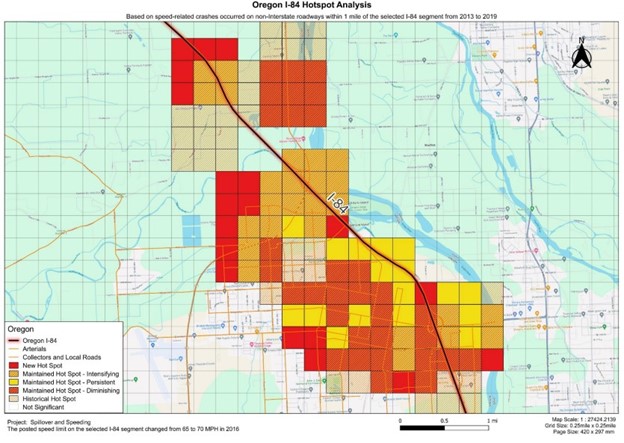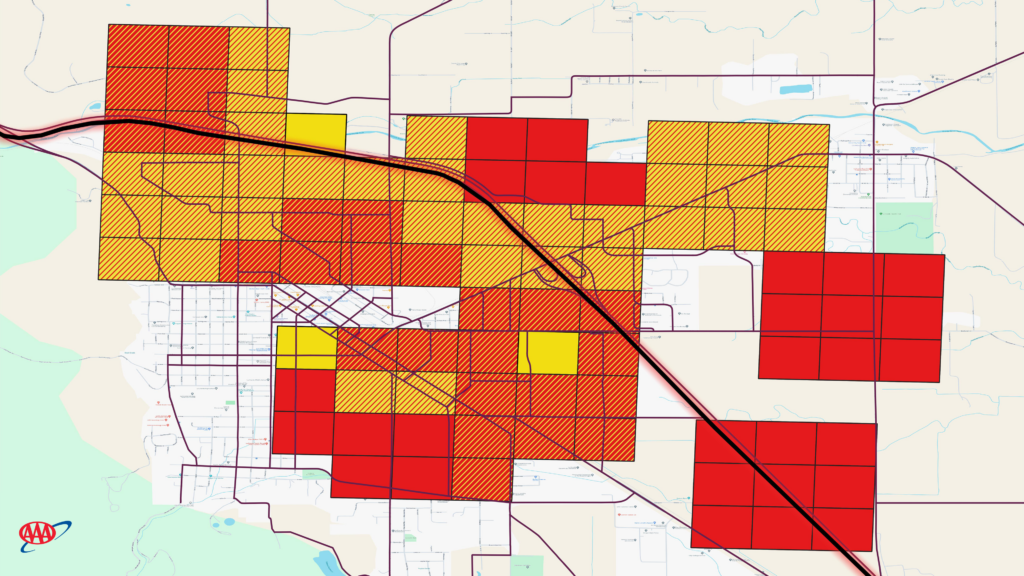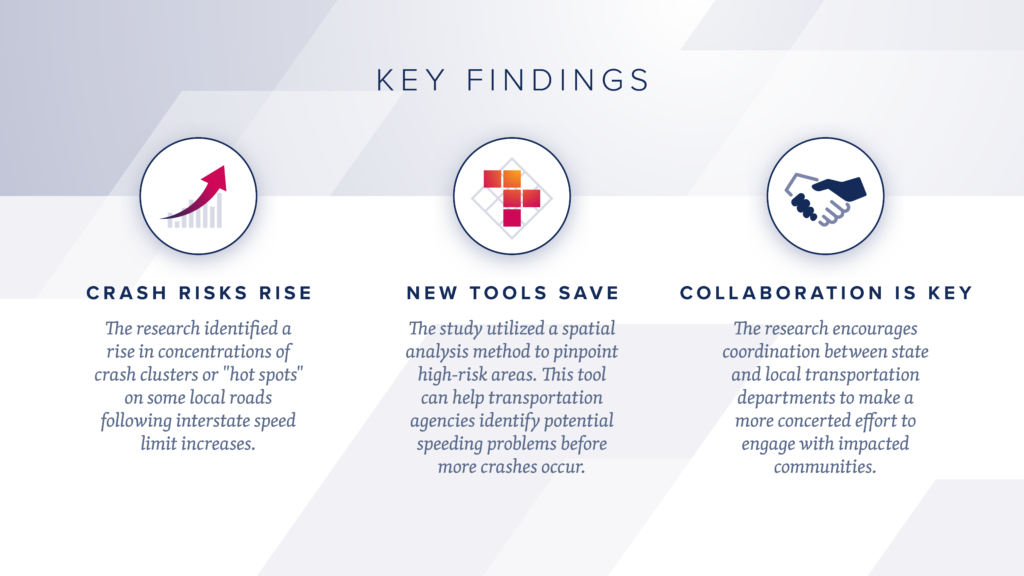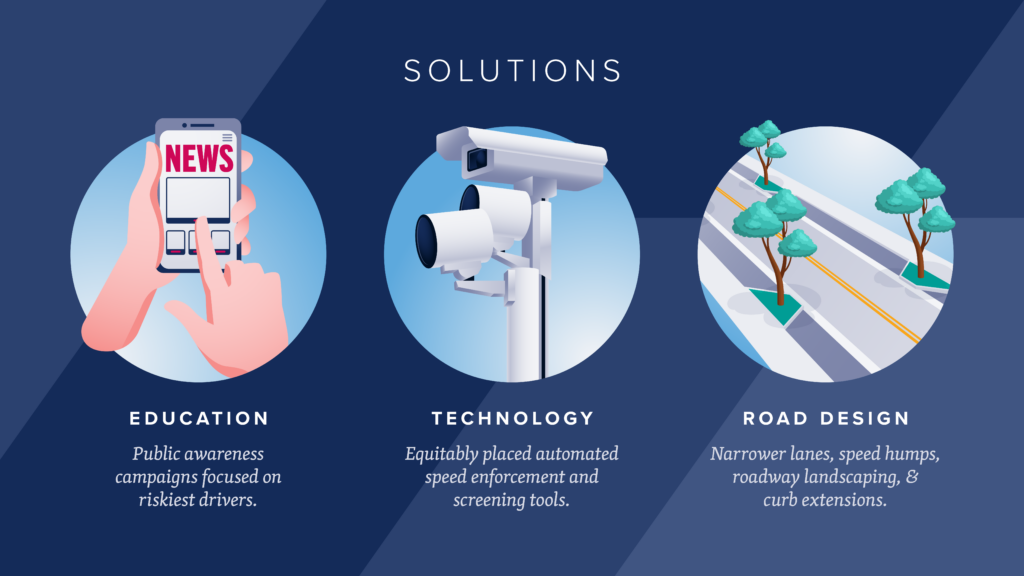New AAA Research in Oregon looks at Spillover Speeding
PORTLAND, Ore., – Raising speed limits on highways could lead to more crashes on nearby roads, according to new research by the AAA Foundation for Traffic Safety. This “spillover effect” can lead to dangerous clusters of crashes or “hotspots” on local roads within a one-mile radius of the interstate.
AAA Foundation researchers investigated whether changes to posted speed limits on interstate highways could cause drivers to adopt risky speeding behaviors on local streets. The study looked at crash data before and after speed limit increases on interstates in Oregon, Georgia, and Michigan. Hot spot analyses were conducted on roads within a one-mile radius of interstates. Researchers found many instances where speed-related crashes increased on nearby roads following the interstate speed limit change, suggesting that drivers exiting the highway continued to drive fast.
This “spillover effect” creates unintended safety hazards for local communities that might not be involved in the decision-making process to raise the posted speed limit on a nearby highway. According to NHTSA, speeding is a significant safety concern, contributing to almost one-third of road fatalities in the past 20 years. In Oregon, there were 602 traffic deaths in 2022 and 587 in 2023, according to the Oregon Department of Transportation Crash Statistics & Reports. Driving too fast for road conditions and exceeding the posted speed limits are major factors in Oregon crashes.
I-84 in Oregon is one of the interstates studied for this project, with the study looking at 291 miles stretching across eight counties (Wasco, Sherman, Gilliam, Morrow, Umatilla, Union, Baker, and Malheur) and going through several cities: The Dalles, Pendleton, La Grande, Baker City, and Ontario. The posted speed limit changed from 65 mph to 70 mph in 2016.
Crash data provided by the Oregon Department of Transportation (ODOT) shows a 3% decrease in all crashes and a 19% reduction of speed-related crashes on I-84 after the speed limit was raised. However, researchers found a troubling spillover effect – an increase in speed-related crash rates on nearby roadways. New hot spots were prominent in Wasco County and Gilliam County among others, where speed-related crashes extended onto roadway facilities beyond interchanges and ramps. Speed-related crashes also intensified in Union County and Malheur County. Please find details starting on p. 54 of the technical report.
Here are hotspots in Malheur County:

Here is the “spillover effect” in La Grande, Oregon:


“This study by the AAA Foundation shows that raising highway speed limits can have unintended and possibly lethal impacts on neighboring communities. The spillover effect can lead to increases in crashes on roads operated by counties, cities and towns. Local roadways are designed for slower speeds and are shared by children, pedestrians, bicyclists and pets – they’re not meant for speeding drivers,” says Marie Dodds, public affairs director for AAA Oregon/Idaho.
AAA believes it’s crucial that state-level transportation planners work closely with local transportation agencies when considering raising speed limits on interstates and state highways.
Other potential solutions include:
- Education – public awareness campaigns targeted at risky drivers
- Technology – equitably placed automated speed enforcement tools
- Road design – narrower lanes, speed bumps, roadway landscaping and curb extensions can calm traffic.
By taking a proactive approach, transportation officials can create safer road networks for all communities. The AAA Foundation’s research reinforces the importance of the Safe System Approach (SSA). The SSA is a strategic way of leveraging the engineering and behavioral countermeasures proven effective at preventing traffic crashes and the injuries that can result from them. Explore the Foundation’s guide for implementing the SSA in your community HERE.

AAA news releases, high resolution images, broadcast-quality video, fact sheets and podcasts are available on the AAA NewsRoom at NewsRoom.AAA.com.
Find local news releases at https://oregon.aaa.com/community/media/media-contacts.html
Fuel prices are updated daily at AAA’s Daily Fuel Gauge at AAA Gas Prices. For more info go www.AAA.com. AAA Oregon/Idaho provides more than 890,000 members with travel, insurance, financial and automotive-related services, and is an affiliate of AAA National, serving more than 64 million motorists in North America.

